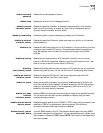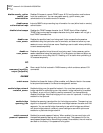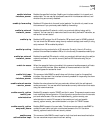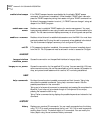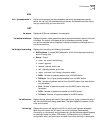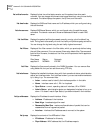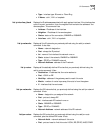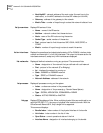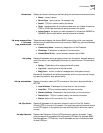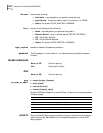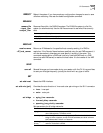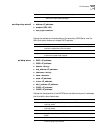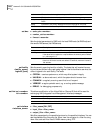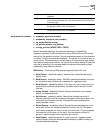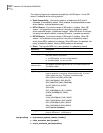
CLI Commands B-21
list services Displays all network services you defined using the add network service command:
■ Name - name of service
■ Server Type - type of service. For example: tftp
■ Socket - TCP port number used by the service
■ Close - reveals whether all connections close when you disable this service:
TRUE or FALSE. See add network service command for details.
■ Admin Status - the status you have requested for this service: ENABLED or
DISABLED. See the add network service command for details.
list snmp communities
or list snmp
trap_communities
These commands display the defined SNMP communities, which you previously
defined using the add snmp community command. SNMP trap_communities does
not list access.
■ Community Name - community designation for the IP address
■ IP address - IP address of a member of the community
■ Access (Read/Write) - type of access a member has to MIBs
list syslog Displays IP addresses which get syslog entries from the system. See add syslog for
more information, and delete syslog command to remove entries. This command
shows:
■ Syslog - IP address to which syslog entries will be sent
■ Log Level - reporting level of entries to send
■ Msg Count - current number of messages sent since system bootup
Also see list facilities and set facilities commands, which let you view and change
log reporting levels for each system facility.
list tcp connections Displays information about all TCP connections. Connection status is defined in
RFC-793.
■ Local Address - IP address of the local host for this connection
■ Local Port - TCP port number used by the local connection
■ Remote Address - IP address of the remote host for this connection
■ Remote Port - TCP port number used by the remote connection
■ Status - status of the connection. E.g.: Listen
list tftp clients Displays IP addresses of all users who allowed to use the Trivial File Transfer
Protocol (TFTP) to connect to the system. You must have used add network service
to add TFTP support to the system and used add tftp client to authorize users to
connect.
list udp listeners Displays User Datagram Protocol (UDP) ports being used by the system. These
ports correspond to processes which are receiving UDP data (for example SNMP,
User Management, TFTP service). Local IP addresses and port numbers are listed
for each UDP port.



